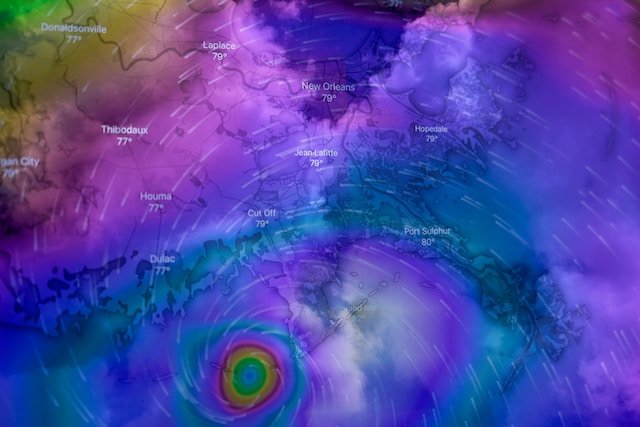You know that feeling when you’re all set for a beach day, only to wake up to unexpected rainfall? Or when an unanticipated cold snap throws off your outfit planning? It’s all because the weather can be as unpredictable as it is fascinating.
This piqued my interest and led me on a journey through the complex world of meteorology. Imagine my surprise when I stumbled upon a study published in Science indicating that an AI model developed by Google’s DeepMind had outperformed traditional forecasting methods! Now we’re talking future-level stuff here, folks! So grab your metaphorical umbrellas and let’s dive into this engaging topic – how AI is rewriting the rules around our daily chats about the weather and transforming ways we prepare for potential disasters.
Key Takeaways
- Google’s GraphCast AI model has surpassed traditional methods in weather forecasting, providing faster speed, greater accuracy, and lower costs.
- GraphCast can predict the weather for 10 days ahead in less than one minute, outperforming old ways of predicting by being three days earlier with Hurricane Lee’s landfall prediction.
- AI – based methods like GraphCast are more efficient and accurate, consuming less energy and delivering predictions that are 1,000 times cheaper compared to traditional methods.
AI Outperforms Conventional Methods in Weather Forecasting
Google’s GraphCast model has proven to be a game-changer in the field of weather forecasting, outperforming conventional methods for the first time with its faster speed, greater accuracy, and lower costs.
Google’s GraphCast model
Google’s GraphCast is a neat tool. It uses AI to guess how the weather will be in the future. This AI model works faster than other ways. It can predict what the weather will be like over 10 days, and it does this in less than one minute! That’s quicker than most traditional methods.
Plus, it makes fewer mistakes and saves money too.
GraphCast learns from past weather data for over 40 years. It checks old records of things like wind speed, temperature and humidity. The best part? Google’s GraphCast was right about where Hurricane Lee would hit nine days early!
Faster speed
AI weather forecasting beats old ways in speed. Google’s model, GraphCast, is super fast. It can tell us the weather for 10 days ahead in less than one minute. This means we know much sooner what the air will do.
Old ways of telling the weather took more time and energy. With AI, we save both these things while getting results faster!
Greater accuracy
The AI model, GraphCast, is very good at guessing the weather. It was right about Hurricane Lee hitting Nova Scotia nine days before it happened. This is three days earlier than old ways of predicting the weather.
Like this, in many cases, AI models are better at forecasting weather than old methods. They still can’t give as much detail as old ways yet but they are getting there. The main point here? GraphCast gives us a way to tell what the weather will be like that is faster and often more right than older ways we have used.
Lower costs
The AI model, GraphCast, has the potential to significantly lower costs in weather forecasting. It is estimated to be about 1,000 times cheaper in terms of energy consumption compared to traditional methods.
This means that using AI for weather forecasting can save a lot of money and resources. It’s an exciting development that shows how AI technology can bring about positive changes in various industries.
Advances in AI Weather Forecasting
One of the most exciting advances in AI Weather Forecasting is Google DeepMind’s AI system, which has shown improved precision in extreme weather forecasting compared to traditional methods.
This means more accurate predictions and better preparation for severe weather events. Read on to discover how this groundbreaking technology is revolutionizing the field of meteorology.
Google DeepMind’s AI system
Google DeepMind’s AI system, called GraphCast, has proven to be a groundbreaking advancement in weather forecasting. In a recent study, GraphCast outperformed conventional methods in predicting global weather conditions up to 10 days in advance.
It demonstrated superior performance over the European Centre for Medium-range Weather Forecasts (ECMWF) system in terms of accuracy and speed. The AI model utilizes a machine-learning architecture trained on four decades of historical weather data.
Not only is it faster and more accurate than traditional methods, but it also consumes significantly less energy, making it more cost-effective. This development opens up exciting possibilities for improved navigation, economic benefits, and better preparation for extreme weather events.
Comparison to traditional methods
AI-based methods of weather forecasting, like Google’s GraphCast, have proven to be significantly more efficient and accurate compared to conventional techniques. Here’s a detailed comparison:
| Criteria | AI-Based Methods (GraphCast) | Traditional Methods (ECMWF System) |
|---|---|---|
| Speed | Delivers predictions in under one minute | Requires considerably more time due to complex equations and calculations |
| Accuracy | Outperformed ECMWF system in 90 percent of 1,380 metrics in a comprehensive evaluation | Has a lesser accuracy rate due to the limitations of conventional numerical weather prediction methods |
| Cost and Energy Efficiency | Estimated to be about 1,000 times more energy-efficient, reducing costs and environmental impact | Relies on supercomputers, resulting in higher energy consumption and costs |
| Data Source | Uses a “graph neural network” machine-learning architecture trained on four decades of ECMWF’s historical weather data | Based on processing equations derived from atmospheric physics |
Predicting extreme weather events like hurricanes and storms also demonstrated the superiority of AI-based methods. For instance, GraphCast was able to predict Hurricane Lee’s landfall in Nova Scotia nine days in advance, three days earlier than traditional approaches. However, AI models do have limitations, including less granularity in forecasts and a lack of transparency due to their ‘black box’ nature. Still, the advantages of AI-based weather forecasting are undeniable and hold great promise for the future.
Improved precision in extreme weather forecasting
AI has made significant advancements in improving the precision of extreme weather forecasting. With the development of AI meteorology models like GraphCast by Google DeepMind, forecasters can now predict severe weather conditions with greater accuracy.
In a recent study, GraphCast outperformed traditional weather forecasting methods in 90 percent of metrics, including temperature, pressure, wind speed and direction, and humidity at different atmospheric levels.
This means that we can now better prepare for extreme events such as hurricanes or storms well in advance. The improved precision offered by AI technology opens up new possibilities for navigating dangerous weather conditions and minimizing the impact of these events on our lives and economies.
Implications of AI Weather Forecasting
AI weather forecasting has significant implications for various aspects of society, such as easier navigation, economic benefits, and better preparation for extreme weather events.
Easier navigation
AI weather forecasting has the potential to make navigation easier for everyone. With AI models like GraphCast, developed by Google DeepMind, we can get more accurate and reliable forecasts.
This means we can plan our activities better and make informed decisions about travel routes or outdoor events. AI weather forecasting can help us avoid unexpected weather conditions and stay safe on the road.
It’s exciting to think about how AI technology will continue to improve our ability to navigate through different weather conditions in the future.
Economic benefits
The use of AI in weather forecasting brings several economic benefits. Firstly, it allows for more accurate predictions, which can help industries such as agriculture and energy plan their operations more effectively.
With better forecasts, farmers can optimize irrigation and planting schedules, while energy companies can adjust power generation to meet demand.
Additionally, AI-powered weather forecasting models are faster and more efficient compared to traditional methods. This means that the costs associated with collecting and processing data are significantly reduced.
The lower costs make it easier for organizations to access reliable weather information without breaking the bank.
Furthermore, accurate weather forecasts enable businesses and individuals to prepare for extreme weather events like hurricanes or blizzards in advance. This preparation reduces the potential damage caused by these events and helps save money on repair costs.
Preparing for extreme weather events
Preparing for extreme weather events is crucial to protect lives and property. With the advancements in AI weather forecasting, we can now have more accurate predictions which can help us better prepare for these events.
The AI models, such as Google’s GraphCast, have shown superior performance in predicting global weather conditions up to 10 days in advance. This means that we can be alerted earlier about approaching hurricanes or severe storms, giving us more time to evacuate or take necessary precautions.
Additionally, the improved precision of AI forecasting can aid in planning emergency response strategies and allocating resources effectively. By leveraging the power of AI, we can enhance our resilience towards extreme weather events and minimize their impact on our communities.
Conclusion
In conclusion, a groundbreaking study published in the journal Science shows that AI is now leading the way in weather forecasting. Google DeepMind’s GraphCast model has outperformed conventional methods for the first time, offering faster speed, greater accuracy, and lower costs.
While AI still has some limitations, researchers believe it will be a valuable complement to traditional weather forecasting methods in the future.




